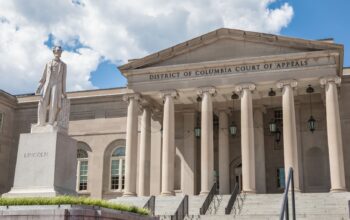by
The Federal Railroad Administration (FRA), under the U.S. Department of Transportation (USDOT), has announced an investment exceeding $93.7 million in rail grants for the District of Columbia. The financing is part of a broader $2.4 billion national investment through the Bipartisan Infrastructure Law, targeting 122 rail improvement projects across 41 states and Washington, D.C. Administration officials said the initiatives will enhance rail safety, reliability, and resilience while reducing disruptions, shipping costs, and pollution.
The funding, distributed through FRA’s Consolidated Rail Infrastructure and Safety Improvements (CRISI) Program, covers various enhancements: upgrading tracks, rehabilitating bridges, expanding port rail connections, and adding environmentally friendly locomotives. Significantly, CRISI is the sole federal program prioritizing support for short-line railroads, which are crucial to regional economies and supply chains, especially in rural areas.
“This marks the most significant investment in American rail in over 50 years,” U.S. Transportation Secretary Pete Buttigieg emphasized, underscoring the Biden-Harris Administration’s commitment to a stronger, safer transportation network.
“Each project advances a future where our supply chains are stronger, passenger rail more accessible, and freight movement safer and more efficient,” Buttigieg added.
FRA Administrator Amit Bose added that the historic scale of the investment would reverse decades of underfunding.
“Today’s CRISI grants will enhance rail safety, connect communities and ports, support workforce development, and provide the world-class rail our citizens deserve,” Bose said.
Highlighted projects include:
- Mechanical Craft Workforce Development Apprenticeship Training Program ($14.4 million): The Amtrak-led initiative will establish a 36-month mechanical apprenticeship, offering career paths for maintaining Amtrak’s equipment fleet. Scheduled in multiple states, the program addresses essential rail safety and performance workforce needs, aligning with CRISI’s workforce development focus.
- Short Line Data Infrastructure Advancement Project ($20.5 million): The American Short Line and Regional Railroad Association is in charge of the project, which aims to improve data infrastructure for short-line railroads. Improvements in data accuracy and analysis on metrics like energy use and emissions will enable strategic freight system enhancements, supported by contributions from multiple short-line railroads.
- Shunt Enhancement Safety Project ($58.8 million): Amtrak will install Onboard Shunt Enhancement (OSE) devices on 443 locomotives and 192 cab cars nationwide, a safety measure designed to prevent trains from losing critical safety signaling. The project involves support from numerous state transportation departments and reflects a commitment to rail safety.
Additionally, the USDOT and FRA have advanced rail safety under the Biden-Harris Administration by finalizing new regulations, conducting safety audits, expanding safety programs, and advocating for paid sick leave for Class I freight railroad workers.
“We are building a rail network that not only meets the needs of today but anticipates the demands of tomorrow,” Bose emphasized. “This funding represents a transformative step forward for our communities, our workforce, and the economy.”
Rail Improvements and the Environment
Working to improve the rail will not only help with efficiency and safety, but will contribute to a healthier environment overall.
While transporting goods via the railway might work in providing jobs and boosting the economy, it can also adversely affect health for those working on, living near or regularly exposed to pollutants from trains.
“Health impacts from the air pollution associated with goods movements include respiratory illnesses, increased premature death, risk of heart disease, cancer risk, adverse birth outcomes, effects on the immune system, multiple respiratory effects and neurotoxicity,” according to a PubMED Central study posted in the NIH National Library of Medicine.
Further, the study showed that primarily Latino (82.3%) and African American (9%) residents live within one-half mile of the railyard, contributing to further health disparities and challenges facing brown and Black communities.
Through their research, the study’s authors conclude work to improve the railyard and locomotives would not only reduce risk from air pollution, but help “address significant cooccurring community challenges.”
“A ‘Health in All Policies’ approach is warranted in addressing impacted communities in close proximity to the goods movement industry,” according to the study’s authors. “Our findings suggest that future efforts to reduce exposure to air pollution must take into consideration other major community challenges, including increased access to health care and a reduction in community violence.”
The FRA funding will help in combating environmental injustice and promoting health for the employees of and people near the San Bernardino Railyard as well as in those in close proximity to transportation hubs across the nation.“Today’s CRISI grants will enhance rail safety, better connect towns, cities, and ports, introduce more environmentally friendly locomotives, support the current rail workforce, and provide workforce development opportunities essential to the future of our industry and the national economy,” Bose concluded.
Source: Published without changes from Washington Informer Newspaper




